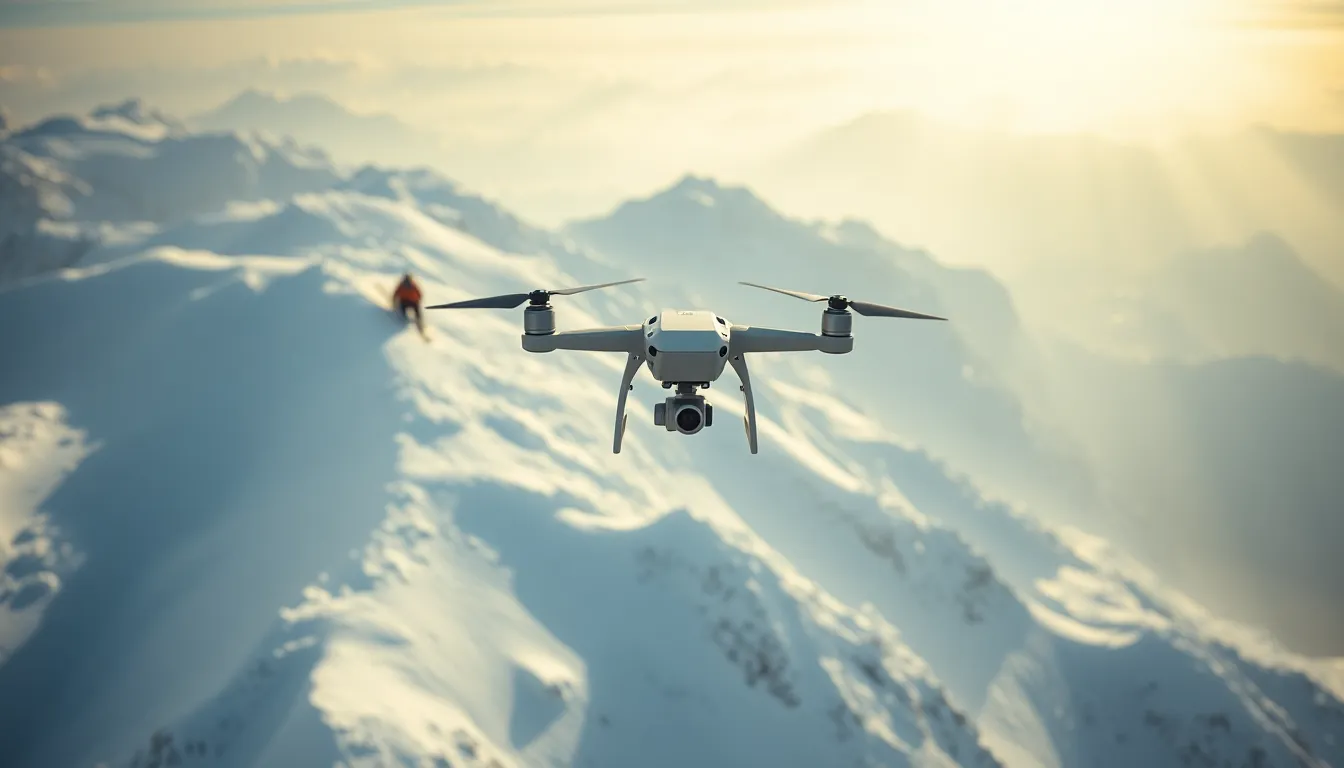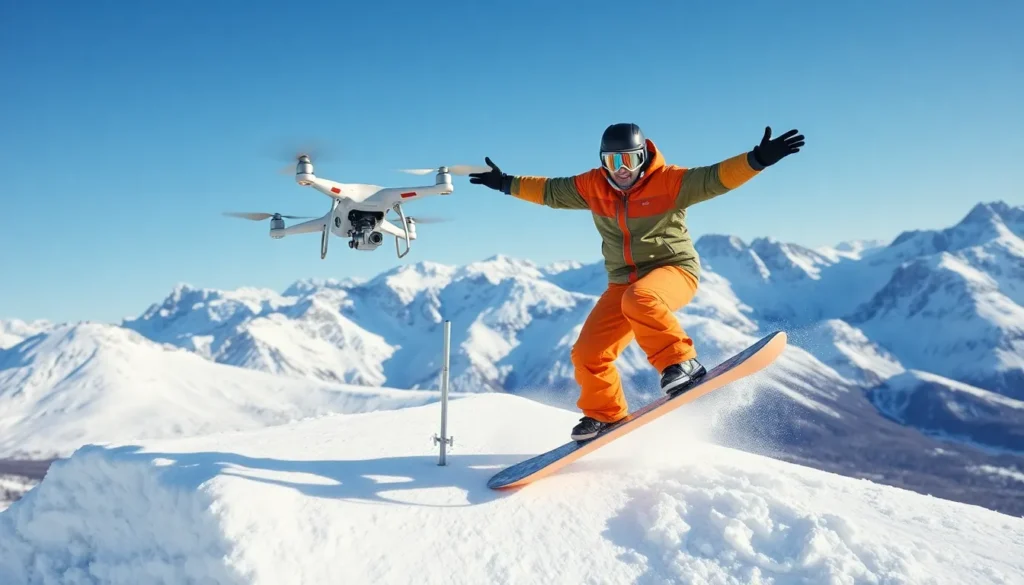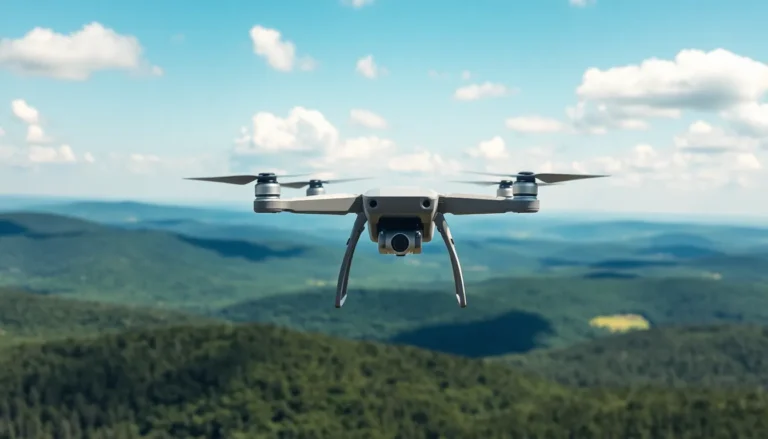Imagine soaring through the air, adrenaline pumping, while a drone captures every heart-stopping moment of your extreme sports adventure. Drones have become the ultimate sidekick for thrill-seekers, transforming how they document and share their wild escapades. Whether it’s snowboarding down a mountain or catching air on a BMX bike, these flying gadgets are now essential gear for anyone looking to elevate their game—literally.
Table of Contents
ToggleOverview of Drones for Extreme Sports
Drones play a crucial role in extreme sports by providing unique perspectives and enhancing the overall experience. These devices capture breathtaking aerial footage during activities like snowboarding, mountain biking, and skydiving. Enthusiasts often use drones to document their adventures, allowing them to relive and share unforgettable moments.
Many models are designed specifically for rugged environments, ensuring durability and stability. Features such as high-definition cameras and real-time transmission make these drones invaluable for thrill-seekers. Capturing dynamic movements and breathtaking landscapes enhances both personal enjoyment and content creation.
Drone technology constantly evolves, making them more accessible to users. Various options are available, ranging from beginner-friendly models to advanced drones equipped with sophisticated features. Each type caters to specific needs and skill levels, encouraging wider participation in extreme sports.
Safety remains a priority when flying drones in extreme conditions. Users must comply with regulations and guidelines set forth by organizations like the Federal Aviation Administration (FAA). Responsible flying practices contribute to a safer environment for both the drone operator and fellow athletes.
Social media has amplified the influence of drones on extreme sports. Thrill-seekers increasingly share their footage on platforms like Instagram and YouTube, inspiring others to explore these activities. As a result, a growing community of drone enthusiasts is emerging, all eager to capture their adventures from new heights.
Benefits of Using Drones in Extreme Sports

Drones significantly enhance the experience of extreme sports participants by providing various benefits that improve safety and tracking capabilities.
Enhanced Safety
Drones enhance safety during extreme sports by offering a bird’s-eye view of activities. This aerial perspective allows athletes to identify potential hazards in their surroundings. In situations where visibility is limited, drones offer crucial insights, helping to prevent accidents. They streamline rescue operations, as ground crews can swiftly analyze environments from above. By using drones, participants can navigate challenging terrains more confidently. Implementing drone technology in sports like skiing or mountain biking encourages safer practices overall.
Real-Time Monitoring
Real-time monitoring through drones enables athletes to analyze their performance immediately. Drones capture high-definition footage, allowing instant playback for technique assessment. This feature serves as a valuable tool for coaches and athletes looking to improve skills. Drones track speed and position during high-adrenaline moments, offering data that enhances performance evaluation. They enhance communication between team members during competitive events, ensuring everyone stays aligned with strategies. Using drones for real-time data provides a modern edge that traditional methods lack.
Popular Extreme Sports Utilizing Drones
Drones significantly enhance the experience in various extreme sports by capturing both action and scenery. They provide athletes and spectators unique perspectives that traditional cameras can’t achieve.
Mountain Biking
Mountain biking showcases breathtaking trails and challenging terrain. Drones follow riders, capturing jumps and turns from above. High-definition video allows viewers to appreciate the speed and skill involved in this sport. Real-time feedback from drone footage helps bikers refine techniques and improve performance by identifying areas for improvement.
Paragliding
Paragliding benefits immensely from aerial footage. Drones track pilots as they navigate through diverse landscapes, emphasizing the beauty of soaring heights. The ability to capture dynamic flight patterns and interactions with nature enhances both promotional material and personal experiences. Additionally, drones assist in safety monitoring, ensuring that conditions are suitable for flying while providing crucial information about nearby obstacles.
Surfing
Surfing relies heavily on drone technology for capturing the power of the ocean. Aerial views highlight the surfer’s movements and wave patterns, revealing the sport’s intricate dynamics. Drones document not just individual performances but also overall ocean conditions, aiding in safety assessments. High-quality footage becomes valuable content for social media, attracting attention and fostering engagement among the surfing community.
Key Features to Look For in Drones
Selecting the right drone for extreme sports involves understanding several key features. These factors enhance the overall experience and ensure maximum performance during thrilling activities.
Camera Quality
Camera quality stands as one of the most critical features in a drone. High definition capabilities facilitate stunning aerial footage, capturing details from breathtaking landscapes to dynamic athletic movements. A drone equipped with a gimbal stabilization system minimizes vibrations, ensuring smooth video capture even during intense action. Look for drones that offer 4K resolution or higher for exceptional clarity, enabling athletes to document their skills effectively.
Flight Range and Battery Life
Flight range and battery life play essential roles in the practicality of drone use for extreme sports. A longer flight range allows users to capture footage from greater distances, providing unique perspectives on their adventures. Battery life affects how long the drone can operate continuously; therefore, opting for models with a minimum of 20 minutes of flight time helps athletes avoid mid-air interruptions. Innovative battery management systems help optimize power use, extending flight durations during critical moments.
Durability and Weather Resistance
Durability and weather resistance ensure that drones can withstand the challenges of extreme sports environments. Models constructed from robust materials can endure crashes and rough handling, extending their lifespan. Water-resistant features protect drones from rain or splashes during activities like surfing. Users should also consider temperature resistance, as colder conditions can affect battery performance. Investing in a drone designed for rugged use ensures reliability and effectiveness during demanding outdoor adventures.
Drones have transformed the landscape of extreme sports by providing unparalleled opportunities for capturing and sharing exhilarating moments. With advancements in technology, these devices not only enhance the thrill of activities like snowboarding and paragliding but also promote safety and performance analysis.
As athletes embrace the aerial perspective drones offer, they’re able to refine their skills and navigate challenging terrains with greater confidence. The growing community of drone enthusiasts continues to thrive on social media, showcasing breathtaking footage that inspires others to explore the world of extreme sports.
Investing in the right drone can elevate any adventure, ensuring unforgettable experiences are documented from unique angles. With responsible flying practices in mind, thrill-seekers can enjoy the full benefits of this innovative technology.





